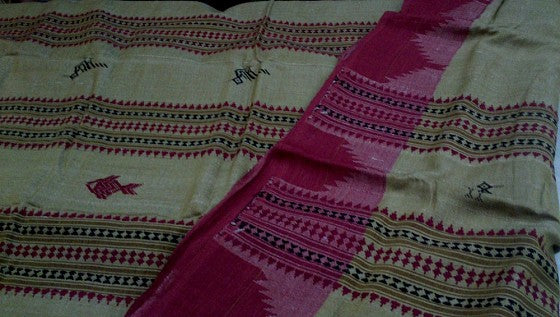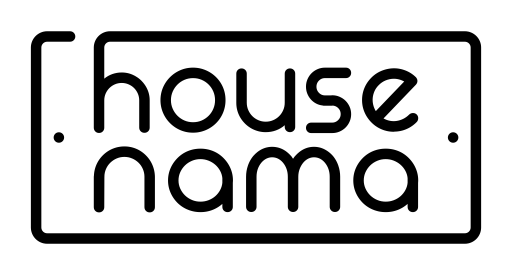Koraput fabric is rough, coarse to the touch, yet soft on the skin and completely organic. Like a wildflower’s unrefined beauty, Koraput’s elegance lies in its simplicity. Woven for centuries in Kotpad – a dusty little town in Odisha, this fabric is entrenched in Kotpad’s regional identity.

Vegetable dyed Kotpad Fabric
What’s unique about Kotpad?
Kotpad is the only region in India where Aal dyeing is done in the most indigenous and traditional manner and waste management is also highly effective. The craft is languishing as the dyers and weavers find it difficult to market the Aal dyed fabrics at a price which is higher than other naturally dyed fabric. The only way to preserve this dying tradition of self sustaining natural dyeing process is to spread awareness of Aal dyeing and to promote the fabrics as a premium product.

Koraput yarn has been woven for centuries on looms like this
Traditionally woven by the Mirgan community, Koraput yarn is dyed in warm reds and maroons with the roots of the Indian Madder or Aal keeping it completely organic and exalted on the green index.
Ancient roots
The process of dyeing is a tedious one, handed down generations. With its origins tracing back to the 3rdCentury, Koraput fabric is also an important commodity in the region’s micro-economy. Right from sourcing the raw materials that are either bought or bartered to selling it, Koraput greases the wheels of the local economy.
The two things that make Koraput unique are its ancient dyeing technique – deriving colour from the Aal root, the inclusion and importance of women in the dyeing process and the organic nature of the dye; and the traditional weaving methods used by the Panika who continue to use pit looms till date.

Mixed with castor oil and cow dunk the yarn is soaked in ash water
The purity of tradition
The weavers of Kotpad hold diligently to tradition. The temptation would be there to experiment with new designs or faster techniques, but they value their heritage and want to preserve it by remaining pure to the form. The cloth is made from mill spun yarn, purchased in a neighbouring market in Bastar, Chattisgarh.
The untreated natural cotton coloured yarn is often bleached whiter for the white grounds. Castor oil and cow dung paste are massaged into the hanks of yarn and they are soaked in ash water baths and then dried in the sun for 12 days to get an even light colour. The massage happens by way of the dyer's feet, which is probably a lot easier on the dyer. This process is surprisingly gentle on the fibres, which are rendered incredibly soft by all the massaging. The coloured fibres are also treated with cow dung and ash water rinsed and dried for 14 days before they are put in the dye bath.

The yarn is dried in the sun for 12 days to get an even light colour
A thick sludge of finely ground aal powder and boiling water is stirred vigorously and the hank of fine yarn is dipped and wrung through with the mixture. The fibres are wrung with the feet, completely impregnating them with dye. They are then returned to the dye pot to soak for the rest of the day in the sun.
The dye pots are given a black tikka of charcoal to protect against evil eye while they are getting their all day sun bath. The pots slowly turn redder as they sit in the sun. Only clay pots are used for the process.

The fibres are wrung with feet completely impregnating them with dye.
The aal can be made browner by the adding iron dust to the dye pot. The fibres are always dyed and dried at least twice. If an even deeper colour is required they will be dyed a third time. The fibres are sun dried after a long afternoon soak in the dye bath, which reduces quite a bit by evaporation over the course of the afternoon. The long thorough mordanting makes the fibres so receptive to the dye that no further fixing is necessary. The maroons, pinks and browns are exceptionally fast and wildly complex colours.
Stories in motifs
Locally known as ‘Pata’, Koraput was traditionally created by the Mirgan for the Koraput Raja and subsequently for different tribes in the area – like the Muria, Gonda and the Bhatra among others, highlighting their respective motifs, making the fabric a visual code for that community.
For instance motifs like the Sacred Axe signifies the Paroja tribes and the Palanquin Bearers are a symbol of the Gadaba tribes. These motifs, inspired by the abundant nature around the Panika (the weaver) also include Bili-khoj (Cat’s Paw), Machari (fish) and Prajapati (butterfly). Rife with symbolism, the motifs are used to identify significant life moments like weddings, birth of a child and the hunting season making Koraput culturally significant as well.

Henna green Kotpad Saree
These saris and shawls are generally done in two colours, one ground and one ornament colour, which is traditionally red on white grounds. All ornamentation is made with the secondary colour. They weave in pure cotton, silk and silk/cotton mix. When you feel this fabric you can feel all those hours of intention put into it - they have some incredible level of softness magic, there is nothing like it!

